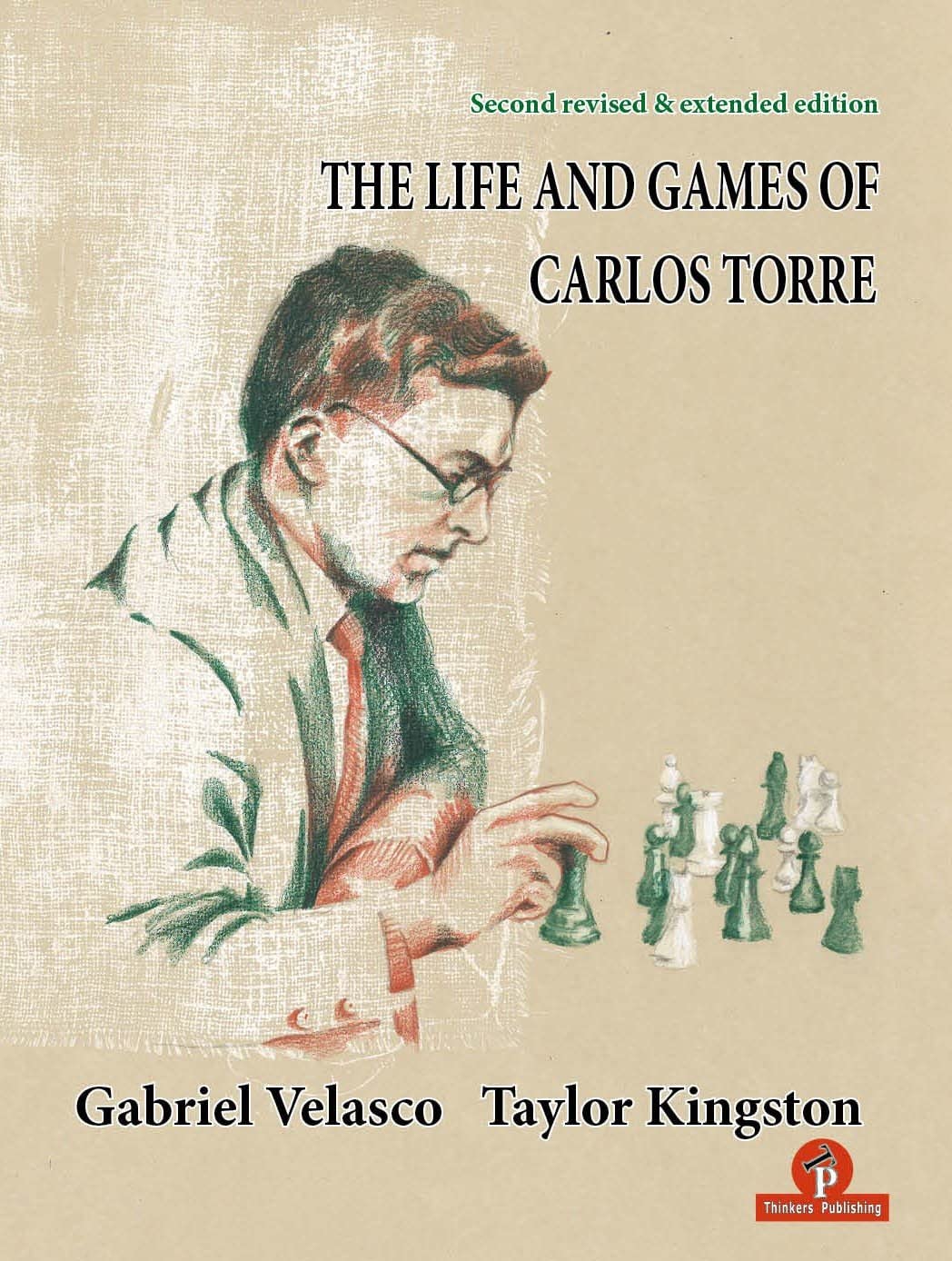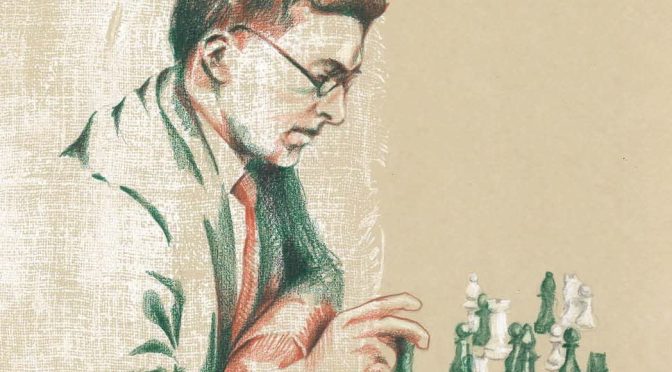From the publishers’ blurb:
“This is what’s new in this edition: More accurate and more extensive annotations, computer-assisted. Every game has been examined under Stockfish 14, probably the best analytical engine available for home computers at this time. For the first edition we had only Fritz 4 and 5, which compare to Stockfish like a Model T Ford to a Ferrari, and many games were given no computer examination at all. Thus owners of the first edition will find most annotations here substantially different (and substantially better). However, many general assessments and heuristic notes proved valid and have been retained. ·
Torre’s own annotations to several games have been unearthed and added. These come from several sources: the American Chess Bulletin, his book of the 1926 Mexican Championship tournament, and his instructional booklet Development of Chess Ability. ·
Several games have been added. Some, frankly, are Torre losses, which we give in the interest of presenting a more complete, balanced picture of his play. The first edition, to some extent, looked at Torre through rose-colored glasses; here we aim only for untinted clarity. Also added are the six games between players other than Torre that he annotated for the Mexican Championship tournament book (see Chapter VIII). ·
There are many more diagrams and photographs than in the first edition. Also more thumbnail bios of Torre’s opponents. ·
More ancillary material about Torre’s life and career: pictures, anecdotes, interesting facts, opinions, bits of trivia etc., drawn from the ACB, the Wiener Schachzeitung, the film Torre x Torre, and other sources. ·
A 1927 interview with Torre, published in the Yucatán magazine Anahuac, in Chapter III. ·
Chapter IV, excerpts from the book 64 Variaciones Sobre un Tema de Torre by his friend Germán de la Cruz.”
About the Authors
Taylor Kingston (born 1949) has been a chess enthusiast since his teens. He holds a Class A over-the-board USCF rating, and was a correspondence master in the 1980s, but his greatest love is the game’s history. His historical articles have appeared in Chess Life, New In Chess, Inside Chess, Kingpin, and the web-site www.ChessCafe.com. He has edited and/or co-authored dozens of chess books, and translated three from Spanish, including the original Mexican edition of Vida y Partidas de Carlos Torre. He lives with his wife Emily in Paso Robles, California.

Gabriel Velasco (born 1949 in Mexico City) is a a professor of mathematics and author of over twenty books on mathematics. He has been a chess enthusiast since age 15. Besides Vida y Partidas de Carlos Torre, he is the author of Masterpieces of Attack (Chess Digest, 1990), presenting the best games of the late GM Marcel Sisniega Campbell. Velasco lived in Kiev 1985-1987 and shared 1st-3rd prize in a tournament of Candidate Masters and First Category players, earning thereby a norm of Candidate Master of the Soviet Union. Back in Mexico, he won the championship of the state of Guanajuato. He is now retired and lives in Mexico City with his wife and his son Richard, who was was given that name in honor of Richard Réti.
You probably know a few things about Carlos Torre. (In the interests of cultural sensitivity we now refer to people from some Spanish speaking countries by their first name, father’s surname and mother’s surname, so he’s now Carlos Torre Repetto, although I’ll refer to him just as Torre in the rest of this review.)
You may know he lost a Famous Game against the otherwise unknown EZ Adams. As always, click on any move for a pop-up window.
A beautiful game, to be sure, and one which is great if you want to teach combinations based on back rank mates. But it almost certainly wasn’t lost by Torre. As explained here on pp484-485, it was quite likely to be analysis which Torre published as a loss against his first teacher, Edwin Ziegler Adams, for whom he had great affection.
The next thing you probably know about Torre is that he won a Famous Game against the not at all unknown Emanuel Lasker.
Again, the finish is a great example of a windmill combination which everyone should know. But it wasn’t, as is demonstrated here (pp356-361) a very good game. Lasker, perhaps distracted by the receipt of a telegram, could have won material with 22… f6 and 23… Qd5 was a losing error.
The third thing you might know about Torre is that he invented the Torre Attack (1. d4, 2. Nf3, 3. Bg5), as he played in this game. The opening bears his name because of his usage here and in other games, but it had been played many times before.
Carlos Torre Repetto played some much better games than this in his very short international career. If you’re eager to find out more, you’ll want to read this book.
Vida y Partidas de Carlos Torre, written by Gabriel Velasco, was published in 1993. Taylor Kingston, working with Velasco, translated and expanded this book, which was then published in 2000. I think I may have a copy somewhere, so perhaps you do as well.
Now we have a Second Edition, expanded further by Kingston.
All the games have been re-annotated using Stockfish 14, some more games have been added, we have more diagrams, photographs and biographical details of Torre’s opponents, as well as a wealth of fascinating supplementary material.
Carlos Torre Repetto was born in the Yucatán province of Mexico on 29 November 1904, and, in 1916, the family moved to New Orleans where, under the mentorship of Edwin Ziegler Adams, he made rapid progress in chess.
In 1924 he travelled to New York in search of stronger opposition. After achieving some local successes he travelled to Detroit, representing New York in the Western Chess Association Championship. Here he scored a spectacular success, finishing unbeaten on 14/16, 2½ points ahead of his nearest rivals and 3 points ahead of the even younger Sammy Reshevsky.
The following spring, Torre crossed the Atlantic to take part in the Baden-Baden congress, where, crossing swords with the likes of Alekhine and Rubinstein, he scored a creditable 10½/20. The authors comment that Carlos Torre played somewhat nervously in his international debut. While attaining a respectable 10th place (out of 21), he clearly was more concerned with not losing rather than trying to win.
He then continued, with only a few days in between the two events, to Marienbad, where he played with more confidence, sharing third place with Marshall on 10/15, half a point behind the winners Nimzovich and Rubinstein.
That autumn he took part in his third international tournament of the year, in Moscow. A score of 12/20 left him sharing 5th-6th places with Tartakower, behind Bogoljubow (his greatest tournament result), Lasker (whom he beat in the above game), Capablanca and Marshall. Here, he started strongly but faded in the last few rounds.
However, his game from the penultimate round was one of his best: a delightful minor masterpiece, according to the authors.
He stayed on in the Soviet Union over the New Year, playing in a small quadrangular tournament in Leningrad, where, still tired from his exertions in Moscow, he only managed 50%.
He then returned to Mexico for the first time in more than a decade, winning their national championship with a 100% score. His next tournament was the Western Masters in Chicago, which, as well as most of the top American players, was given an international flavour by the participation of Maroczy. With one round to go, Torre was half a point ahead of the field, facing Edward Lasker, who was in the bottom half of the field, with white in the last round. He was unable to cope with the pressure, played badly and lost. Marshall came out on top with 8½/12, half a point ahead of Torre and Maroczy.
The final thing you might know about Torre is that he once took his clothes off on a bus. Sadly, it’s true. After this tournament he returned to New York where he suffered a psychotic episode which put an end to his brief tournament chess career. He was also suffering from some sort of eating disorder, perhaps brought on by anxiety. He had always had an immoderate fondness for sweets, sometimes eating a dozen pineapple sundaes in a day, but those who knew him in New York at this time report that he was eating almost nothing but candies and fudge. He then returned to Mexico, living there quietly until his death in 1978 at the age of 73, and retaining his interest in chess to the end.
A sad story, then. Here was a young player of exceptional talent who lacked the temperament for competitive chess. Torre comes across as a sensitive soul who, on the one hand was more interested in the beauty of his games than the result, but, on the other hand, was hampered by anxiety which caused him on some occasions to play too cautiously, and, on other occasions, to tire easily and make mistakes.
If you’re interested in chess in the 1920s you’ll certainly want to read this excellent book. You won’t be disappointed with the production qualities either: it’s a good-looking hardback (also available in paperback) of 588 pages. The Games Section covers most of the book: here you have 110 games annotated using the latest (at the time of writing) engines to ensure accuracy.
One of Torre’s most impressive performances was his draw with the black pieces against Capablanca (Moscow 1925). Not many players were able to hold an inferior ending against the World Champion, but he was able (with one exception which Capa failed to take advantage of) to find a string of ‘only moves’.
The annotations to this game demonstrate the improvements from the first edition.
The first edition of the book offered analysis claiming that White could still win if Black played 37… b6! here, but, with the help of Stockfish, this edition demonstrates that Torre could have drawn by following a very narrow path. After the game continuation 37… Kf5?? 38. Nxb7 Ke6 39. Kd3? (Nc5+ was winning), Torre was – just about – holding.
A few moves later, this position was reached.
The game continued 41. Na6+ Kb6 with an eventual draw. Capablanca claimed after the game that 41. Kc3 was winning, but Bogoljubov, writing in the tournament book, disagreed. The first edition sided with Capa, but now, in the second edition, we learn that it was Bogo who was correct.
Here’s the complete game.
The last 100 pages or so offer a wealth of other material including articles and annotations by Torre himself. The games included here bring the total up to 128. Anyone with an interest in chess history will relish this part of the book.
If you already have the first English language edition, then, you’ll want to know whether or not to buy this version. If you want more accurate annotations, the answer is clearly ‘yes’. If you want the fascinating additional material, the answer is again ‘yes’. If you just want Torre’s best games, or if you’re of the opinion that historical games shouldn’t be subjected to computer analysis, the answer may well be ‘no’.
Instead of the familiar Informator symbols you instead get assessments such as (+0.61/25), indicating that Stockfish 14, at 25 ply, considers that White has an advantage of .61 of a pawn. I find this interesting, but I’m sure there will be those who disagree.
There are other production issues which might divide opinion. If you’re a completist you’d expect every traceable game played by Torre, which isn’t what you get here. White spaces in the book are filled with cute little cartoons. You might like this, but here I think I prefer the white space.
If you have any interest at all in chess history, chess culture or the psychology of chess players, you shouldn’t hesitate.
Gabriel Velasco, Taylor Kingston and the team at Thinkers Publishing should be congratulated on doing an outstanding job to preserve the memory of Carlos Torre Repetto’s life and all too short chess career.
Richard James, Twickenham 12th January 2024

Book Details :
- Softcover: 588 pages
- Publisher: Thinkers Publishing; 2nd edition (21 Mar. 2023)
- Language: English
- ISBN-10: 9464201762
- ISBN-13:978-9464201765
- Product Dimensions: 23.88 x 4.06 x 17.27 cm
Official web site of Thinkers Publishing


